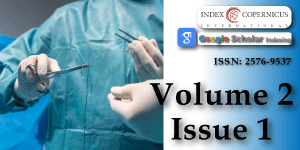Scrotal Hydroceles not associated with Patent Processus Vaginalis in Children
Main Article Content
Abstract
Background: After the closure of patent processus vaginalis (PPV) in boys with indirect inguinal hernia (IIH) or hydrocele, large scrotal hydroceles can occur on rare occasions despite the complete occlusion of internal inguinal ring (IIR). We present some cases that may help to explain the cause of this rare occurrence.
Materials: During last 14 years, six boys exhibited non-communicating large scrotal hydroceles (2 right, 1 left, 3 bilateral) among 352 children who underwent laparoscopic repair for hydroceles. Ages ranged from 7 months to 15 years with a median of 12 years. Five of them had a history of repair for hydrocele or IIH prior to the definitive surgery and one boy underwent an initial operation.
Results: In all the patients, laparoscopic inspection at the definitive surgery revealed completely closed IIRs. One infant with primary hydroceles was found to have large hydroceles bulging into the peritoneal cavity. All the patients were treated with subtotal removal of the sac without any recurrence. Marked thickness of the sack walls with abundant lymph vessels was characteristic histopathological findings.
Conclusions: The complete occlusion of the PPV does not always prevent the recurrence of hydrocele through alternative pathogenesis. The pathological findings of resected specimens suggested a disturbance in lymph flow in the testicular system. The subtotal removal of the sac is the treatment of choice. Diagnostic laparoscopy prior to a direct cut-down approach to the neck of the seminal cord is advisable to identify non-communicating hydroceles to avoid further impairment of lymph drainage around the IIR.
Article Details
Copyright (c) 2018 Endo M, et al.

This work is licensed under a Creative Commons Attribution 4.0 International License.
Koop CE. Groin hernia in infants and children. In: Nyhus LM, Condon RE (eds). Hernia, 4th edn. Philadelphia: JB Lippincott. 1995; 109-110.
Endo M, Watanabe T, Nakano M, Yoshida F, Ukiyama E. Laparoscopic completely extraperitoneal repair of inguinal hernia in children: a single-institute experience with 1,275 repairs compared with cut-down herniorrhaphy. Surg Endosc. 2009; 23: 1706-1712. Ref.: https://goo.gl/2u9SVn
Endo M, Nakano M, Watanabe T, Ohno M, Yoshida F, et al. Laparoscopy assisted one-stage trans-scrotal orchidopexy applicable to all types of maldescended testes. In: Shamsa A (ed.). Advanced Laparoscopy. Rijeka: InTech. 2011; 55-66. Ref.: https://goo.gl/Ly8Hzy
Ein SH, Nasr A, Wales P, Gerstle T. The very large recurrent postoperative scrotal hydrocele after pediatric inguinal hernia repair: a rare problem. Pediatr Surg Int. 2009; 25: 239-241. Ref.: https://goo.gl/WFPjTb
Climador M, Castagnetti M, DeGrazia E. Management of hydrocele in adolescent patients. Nat Rev Urol. 2010; 7: 379-385. Ref.: https://goo.gl/7yCmxR
Ku JH, Kim ME, Lee NK, Park YH. The excisional, plication and internal drainage techniques: a comparison of the results for idiopathic hydrocele. BJU Int. 2001; 87: 82-84. Ref.: https://goo.gl/RruAKf
Wilson JM, Aaronson DS, Schrader S, Baskin LS. Hydrocele in the pediatric patient: Inguinal or scrotal approach?. J Urol. 2008; 180: 1724-1728. Ref.: https://goo.gl/T5MoUn
Wallace AF. Aetiology of the idiopathic hydrocele. Br J Urol. 1960; 32: 79-96. Ref.: https://goo.gl/ZDPXzP
McBrien MP, Edwards JM, Kinmonth JB. Lymphography of the testis and its adnexa in the normal and in idiopathic hydrocele. Arch Surg. 1972; 104: 820-825. Ref.: https://goo.gl/8Wo5Sc
Oswald J, Brenner A, Brenner E, Fritsch H, Schlenk B. Pattern of lymphatic drainage of human testes with respect to hydrocele formation after varicocelectomy in adolescents. J Pediatr Urol. 2009; S81. Ref.: https://goo.gl/bvrN3d
Fourie N, Banieghbal B. Pediatric Hydrocele: A complihensive review. Clin Surg. 2017; 2: 1448. Ref.: https://goo.gl/vYX1g1
Onol SY, Llbey YO, Onol FF, Ozbek E, Arslan B, et al. A novel pull-through technique for the surgical management of idiopathic hydrocele. J Urol. 2009; 181: 1201-1205. Ref.: https://goo.gl/DkWkvg
Nigam VK. Window operation: new technique for hydrocele. Urology. 1984; 24: 481-482. Ref.: https://goo.gl/6NLPah
Aslan M, Kilinc M, Yilmaz K, Ozturk A. A new approach in the management of the hydrocele with a silicone catheter. Urology. 2004; 63: 170-173. Ref.: https://goo.gl/osknVY
Hu KN, Khan AS, Gonder M. Sclerotherapy with tetracycline solution for hydrocele. Urology. 1984; 24: 572-576. Ref.: https://goo.gl/QY8x4f
Ozdilek S. The pathogenesis of idiopathic hydrocele and a simple operative technique. J Urol. 1957; 77: 282-284. Ref.: https://goo.gl/85uvE5
Endo M, Ohno M, Yoshida F, Nakano M, Watanabe T, et al. Laparoscopic hernia repair and its validation by second-look inspection to internal inguinal rings in children with patent processus vaginalis. In: Meinhold-Heerlein I (ed.). Laparoscopy - An Interdisciplinary approach. Rijeka: In Tech. 2011; 133-146. Ref.: https://goo.gl/ce6Guw





